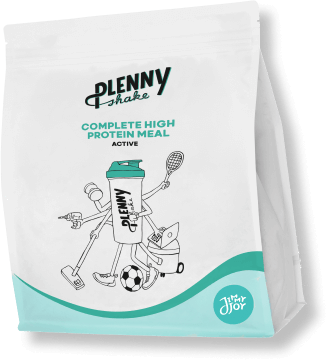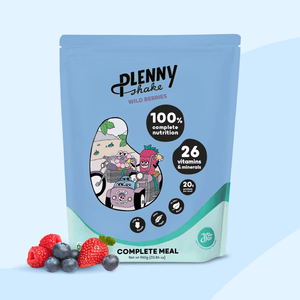Familiarize yourself with nutrition
Nutrients are all the compounds in food that are used directly, or indirectly with the help of bacteria, by your body to perform its amazing functions. Nutrients have various roles: to produce energy, create building blocks and help with special cellular functions.
There are many types, some are essential and cannot be produced by the body itself and some can be made from precursors within the body [1]. A good example of that is proteins. Your body is continuously breaking down and building up a wide variety of proteins, but to do that it needs amino acids and 9 are called essential amino acids because they can only be supplied by food.
Nutrients are classified into macronutrients and micronutrients, macro's and micro's in short, related to the quantity used. Macronutrients are required in large quantities and micronutrients in relatively small quantities. Macronutrients are fats, proteins, carbohydrates, and fiber. Vitamins and minerals make up the micronutrients, tiny essential molecules that do a lot of good! [2] [3] [4]
Introduction to macronutrients
Macronutrients are known as energy providing nutrients but can also be part of the building block of cell components [3] [4]. At the energy level, lipids give the most energy (9kcal per gram of lipid), followed by proteins and carbohydrates that give the same amount of energy (4kcal per gram) [3]. Keep reading to know what they do apart from supplying energy.
Fat
The most controversial f-word in the world: fat. But no need to scream in despair and cut it out of your diet completely. This macronutrient is actually one of the body’s main energy sources. Fat is crucial for the maintenance of the cells in our body, our hormones, and for proper brain function. Still, some fats are better than others. [1]
Saturated Fats
Saturated fats are known as ‘bad fats.’ They are mostly found in animal-derived products such as butter, meat, whole milk and tropical oils such as palm oil or coconut oil. They are solid at room temperature and are not susceptible to oxidation, or to turning rancid when exposed to air. Saturated fats have only single bonds in their atoms. [2]
Risks of saturated fats
The role of saturated fats on health has been widely analyzed, where studies have shown that consuming excessive amounts of these fats may raise cholesterol levels, and in the long term, increase heart disease risk by promoting blood clotting. Therefore, it is important to limit the amounts consumed per day and opt for unsaturated forms of fat. Other fats associated with health risks are trans fats.
Trans fats
Trans fats are created by a chemical process called hydrogenation. Hydrogenation adds hydrogen to liquid healthy oils. This increases their stability and makes them more solid. It also protects them from becoming rancid, which is why trans fats tend to be used to extend the expiration dates of processed foods. Studies have found that eating foods high in trans fats can rise the levels of harmful cholesterol in our blood, as well as cause inflammation, which is linked to increased heart disease risk. [5, 6]
Unsaturated fats
Unsaturated fats are known as ‘good fats'. They are mostly found in plant-derived products such as sunflower oil, flaxseed oil, avocados, nuts, and whole grains. If they are not hidden inside a food, unsaturated fats are liquid at room temperature because of having both, single and double bonds in their structure. [2]
Monounsaturated fats
This type of fat contains only one double bond in its structure. The main food sources you can obtain them from are olive oil, avocados, peanut oil, sunflower oil, and canola oil. They are recommended over saturated fats, as they are thought to reduce bad cholesterol. [7]
Polyunsaturated fats
This type of fat contains two or more double bonds between its carbons. The main food sources you can obtain them from are corn oil, flaxseed oil, soybean oil, sunflower oil and oily fish (such as salmon, mackerel and sardines.) The different types of polyunsaturated fats are Omega 3, 6 and 9 and they are essential fats, meaning that they’re needed for the different body functions, but that our body is not able to produce them, therefore you can only obtain them through food. [7]
Omega-3 fatty acid
Omega-3’s play an active role in the maintenance and development of the retina
(eyes), skin and brain. Fatty acids go through several stages before becoming an omega-3 fatty acid. The 3 most important omega-3 precursors are: alpha-linolenic acid (ALA), docosahexaenoic acid (DHA) and eicosapentaenoic acid (EPA.) [8]
Alpha Linolenic acid (ALA)
Linolenic acid (ALA) is the first precursor of omega-3 fatty acids. It is commonly found in seeds and plant oils, such as flaxseed, sunflower oil, and algae. The human body converts ALA to eicosapentaenoic acid (EPA). The absorption of direct EPA in the body is however much more efficient than when it’s obtained from ALA first. [8, 9]
Eicosapentaenoic acid (EPA)
Eicosapentaenoic acid (EPA) is commonly found in marine creatures such as oily fish. Fish eat algae, which contains ALA. It then converts the ALA into EPA, which is why fish provide a direct source of EPA when consumed by other animals or humans. Your body can also naturally convert the ALA into EPA itself. Studies have shown that intake of large doses of EPA (more than 2.0 to 4.0 g/day) can lower inflammation in the body. [8, 9]
Docosahexaenoic acid (DHA)
Docosahexaenoic acid (DHA) is converted from EPA. Similar to EPA, it can also be obtained through fish and algae oils. It’s the most common omega-3 fatty acid present in the brain and retina. DHA also gets transmitted through breast milk. Some studies claim that this makes it an important nutrient during pregnancy and lactation. [8, 9]
Omega-6 fatty acid
The omega-6 fatty acid has several stages of precursors. The main precursor of the omega-6 family is called linoleic acid (LA), which is found in plant oils. Eventually, LA is turned into arachidonic acid (AA), which helps with the proper growth of skin and hair. It also has anti-inflammatory effects. Omega-6 fatty acids are much more common than omega-3 fatty acids and are found in the vast majority of the foods we eat: whole-grain bread, wheat, most vegetable oils, and cereals. [9, 10]
Omega-9 fatty acid
Omega-9 is a nonessential fatty-acid. Our body is able to create omega-9 itself, for instance, from the unsaturated fats we eat. This fatty acid boosts our energy levels and brain function. Nevertheless, further research is still needed to understand the roles of this fatty acid more precisely. [9, 11]
Protein
Protein is one of the main building blocks of the human body. It’s necessary for the growth, restoration, and maintenance of body cells tissues, bones, skin, and muscles.
No wonder it’s called protein, meaning: of prime importance. Most people associate protein with muscle building, but did you know your muscles work non-stop, even when you sleep? That is why your body needs a steady supply of protein. Proteins are made up of amino acids. But what are they exactly? [1, 9]
Amino acid
Amino acids are the main components of proteins. One protein can have less than 100 to over 30.000 amino acids, and they all have the same structure: a central carbon atom with a hydrogen atom, an amino group, an acid group and a side group that can vary. The variation in the side group determines the type of amino acid. They’re categorized as essential, conditionally essential or nonessential depending on several factors. [1, 9]
Essential AA
Essential amino acids are AA that the human body is either incapable of producing, or can’t make sufficient amounts of it. It’s, therefore, crucial to include these in your diet. Foods high in amino acids are: eggs, soy protein, buckwheat, whitefish, chicken, meat, and seeds (hemp, pumpkin, chia, sesame.) There are nine essential amino acids: Histidine, Isoleucine, Leucine, Valine, Lysine, Methionine, Phenylalanine, Threonine and Tryptophan. [9]
Histidine
Histidine provides structure to hemoglobin. Hemoglobin is the blood protein in charge of transporting oxygen to the majority of our cells and tissues. It also controls the immune response in your skin. [9]
Isoleucine, Leucine, and Valine
This trio is called ‘branched chain amino acids’ (BCAA). They are directly and strongly involved in muscle growth by enhancing the genetic signaling sequence called mTOR. Additionally, these AA’s also participate in the absorption of glutamine and alanine, and important elements such as nitrogen and carbon. [9, 12, 13]
Lysine
Lysine controls the production of nitric oxide. Nitric oxide is a gas that causes our blood vessels to widen, which supports the transport of nutrients and other important molecules through our body. [9]
Methionine
Methionine contains sulfur, which is a molecule that protects your tissues, modifies DNA and maintains the proper functioning of your cells. It also balances out the production of nitric oxide and substances that protect your cells from environmental stress situations, such as the risk of infections, lack of food, water or oxygen. Methionine is involved in the creation of the nonessential amino acid cysteine, which is another sulfur-containing AA important for your body to have. [14, 15]
Phenylalanine
Phenylalanine is key for the activation of nitric oxide (the gas that causes blood vessels to widen) the production of tyrosine (which improves attention and focus) and the neurological development of brain cells. [9]
Threonine
Threonine produces important proteins that help your immune system to stay strong and benefit your gut health. This AA is also needed for the development of the nonessential amino acid named glycine. [9]
Tryptophan
Tryptophan limits the production of the inflammatory cells called cytokines. They put the body in flight-mode, which is an undesired effect when you don’t actually have to run away from a pack of wolves. It also has antioxidant properties, which means it protects our cells from the effects of free radicals. These free radicals cause aging, damage your tissue, and likely cause some diseases [9, 16]
Nonessential AA
Nonessential amino acids are AA that the body is capable of producing itself. It creates them from carbs, fat and nitrogen-containing foods. The 11 nonessential amino acids are Alanine, Arginine, Aspargine, Aspartic acid, Cysteine, Glutamic acid, Glutamine, Glycine, Proline, Serine, and Tyrosine. [9]
Alanine
Alanine provides energy for both our muscles and brain. It acts as a buffer in our muscles, which makes them perform better. This buffering activity consists of regulating the acidity level (pH) in the muscles that get influenced by the different cycles our body works on throughout the day. Alanine also helps with the creation of simple sugar in our liver. [17, 18]
Arginine
Arginine is involved in wound healing and in the production of hormones. It also participates in the detoxification of ammonia. Ammonia is a waste product generated after the digestion of proteins. [9, 13]
Asparagine
Asparagine is involved in the control of cell functions in the brain. It’s also responsible for the detoxification of ammonia. Additionally, it regulates the gene signals that make our immune and nervous system function properly. [9]
Aspartic acid
Aspartic acid plays a role in the normal functioning of the nervous system. It also assists in the production and release of hormones. [9]
Cysteine
Cysteine moves sulfur around the body. Sulfur helps with wound healing and the breakdown of substances external to the body (such as food and medicine.) Cysteine also has an active function as an antioxidant. [19]
Glutamine
Glutamine is the main amino acid involved in muscle growth. It’s often taken as a supplement after exercise to fuel up exhausted cells and to prevent them from dying. Additionally, this amino acid enhances gene expression, immune function and provides energy to the absorptive cells in your small intestine. [13]
Glutamic acid
Glutamic acid is one of the main neurotransmitters in the brain. As you can tell by its name, it takes part in the production of Glutamine. Together with glutamine, it also sustains the nitrogen balance in our body. [20]
Glycine
Glycine improves the entrance of calcium into our cells. It also participates in the production of DNA units. Furthermore, it regulates the development of both signaling molecules and heme-proteins (which are involved in oxygen transport in our tissues and organs.) [9]
Proline
Proline contributes to the formation of collagen. This is the main structural unit of the tissues that connects, supports or separates our organs. Proline also helps to kill pathogens (bacteria and viruses) by strengthening the immune system. [21]
Serine
Serine contributes to the production of essential DNA units and the amino acid tryptophan. It also activates important receptors in our brain, thereby improving the signaling of neurotransmitters that keep up the communication within the brain. [9]
Tyrosine
Tyrosine has most of the functions the other amino acids have: it promotes protein-production, is anti-inflammatory and it has antioxidant capacities. [9, 13]
Conditionally essential AA
Sometimes, a nonessential amino acid can become conditionally essential. For instance when the diet doesn’t supply enough amounts of the nutrients needed to form them, or when you are under a certain disease and the conversion of one amino acid to another can’t be fully done.
In other words, when the need for the AA exceeds the body’s ability to produce it. [1, 22]
Carbohydrates
Carbohydrate is the collective name for the sugars, starches, and fibers that can be found in fruits, grains, vegetables, and dairy products. Carbohydrates are your body’s main energy provider. They also keep your metabolism running and your blood sugar levels stable. Carbohydrates are divided between simple carbs (monosaccharides and disaccharides) and complex carbs (polysaccharides.) [1, 23]
Monosaccharides (simple carbs)
Monosaccharides are the most basic form of carbohydrates and the simplest form of sugar. They contain only one sugar unit. Generally speaking, the body absorbs quickly this type of carbs because of having such a simple structure. The three different monosaccharides are glucose, fructose, and galactose. They all have the same kind and numbers of atoms (carbon, hydrogen, and oxygen) but differ in their arrangement. This gives each of them a different level of sweetness. [1, 24]
Glucose
Glucose, meaning ‘sweet’ in Greek, is the most common monosaccharide. Our body turns 100% of the carbohydrates we eat into glucose, which serves as our body’s essential energy source. When it travels through our bloodstream to our cells, it’s called blood sugar, and the hormone insulin is the one in charge of moving the blood sugar into our cells. People that have diabetes have excessive amounts of glucose in their blood because their insulin balance is off. [25]
Fructose
Fructose occurs naturally in fruits and vegetables. Thanks to its structure, it is known to be the sweetest sugar of them all. Fructose has the ability to stimulate our taste buds twice as much as glucose. Therefore, you would need less of it for sweetening purposes. [1, 9]
Galactose
Galactose is the main carbohydrate component in milk and dairy products. It’s less sweet than glucose and fructose, but it’s still quite close to glucose in structure and taste. It‘s an important component of our central nervous system, hence its nickname ‘brain sugar.’ [9]
Disaccharides
Disaccharides are a slightly more complex form of carbohydrates, but still easy to digest. They contain two sugar units, as they are made when two monosaccharides are paired up. For example, if you combine glucose with galactose, you get the milk sugar lactose. As you can tell, the structure of disaccharides is a bit more complicated than monosaccharides. Therefore, it takes longer for our body to digest and absorb them. [1, 24]
Maltose
Maltose consists of two glucose units bind together. It occurs naturally during the digestion of carbohydrates in your body. Maltose can also be formed during the fermentation process of alcohol, for example during the production of beer or wine. It’s the least sweet sugar of them all. [9]
Sucrose
Sucrose, also known as table sugar, is formed when combining fructose and glucose. Since it contains fructose (which is already really sweet) you can imagine this is the sweetest disaccharide out there. Non-caloric sweeteners such as sucralose are produced out of sucrose to be used as sugar substitutes. This is 600 times sweeter than normal sucrose. Several studies claim that sucralose is poorly absorbed in the body, and therefore the majority of it will be disposed of without influencing your blood sugar levels. [26]
Polysaccharides (complex carbs.)
Polysaccharides are the most complex form of saccharides and take the longest to be broken down by the body. They are formed when a lot of saccharides are combined. For example, when many glucose molecules are connected together, you get glycogen, a polysaccharide that stores energy in your muscles and liver for future use. Fibers are another common polysaccharide. [1, 24]
Fiber
Fiber is one of the main components of plant cells and grains, making it a vital and strong nutrient. So strong that it can resist the early stage of digestion in our body. This enables it to reach our intestines, where it turns into dinner for our hungry gut bacteria. Fiber slows down the rate in which sugar is absorbed into the bloodstream, reducing the risk of heart disease and diabetes. They can also enhance the movement of food through our digestive system depending on if they are soluble or insoluble. [27, 28]
Soluble Fiber
Soluble fibers are able to dissolve in water and turn into a gel during digestion. This makes our stools firmer and more regular. It also binds to glucose (sugar), causing it to be absorbed much slower. Furthermore, soluble fiber is prebiotic, meaning it boosts the population of good bacteria in our intestines. When soluble fibers arrive in our colon (the last bit of the big intestine), a signal is released that tells our brain to stop eating. Therefore, fighting hunger is easier with foods high in soluble fiber such as oats, black beans, lentils, barley, avocados, apples, and strawberries. [9, 29, 30]
Insoluble Fiber
Insoluble fibers don’t dissolve in water, which means that they can’t form gels. They enhance the movement of material through our digestive system and increase the amount of stool. This has a relieving effect for those who suffer from constipation or irregular stools. Foods high in insoluble fibers are wheat bran, whole-wheat bread, brown rice, carrots, broccoli, and green beans. [9, 29, 30]
References and sources
Sources used in the nutrient introduction:
1. Kohlmeier, M., Introduction, in Nutrient Metabolism (Second Edition), M. Kohlmeier, Editor.
2015, Academic Press: San Diego. p. xxiii-xxviii.
2. (WHO), W.H.O.; Available from https://www.who.int/elena/nutrient/en/.
3. Nakamura, T., and S. Kuranuki, Nutrition—Macronutrients, in Encyclopedia of Cardiovascular
Research and Medicine, R.S. Vasan and D.B. Sawyer, Editors. 2018, Elsevier: Oxford. p.
531-537.
4. Nassar, M.F., The macronutrients' interplay. Clinical Nutrition, 2018.
Sources used in the macronutrient section:
- E. Whitney, S.R.R. Understanding Nutrition 2013; 13th edition:[Available from:https://books.google.nl/books/about/Understanding_Nutrition.html?id=OQgLAAAAQBAJ&redir_esc=y.
- WHO. Fats and fatty acids in human nutrition. 2010; Available from https://www.who.int/nutrition/publications/nutrientrequirements/fatsandfattyacids_humannutrition/en/.
- Siri-Tarino, P.W., et al. Meta-analysis of prospective cohort studies evaluating the association of saturated fat with cardiovascular disease. Am J Clin Nutr 2010 Mar [cited 91 3]; 2010/01/15:[535-46]. Available from: https://www.ncbi.nlm.nih.gov/pubmed/20071648?itool=EntrezSystem2.PEntrez.Pubmed.Pubmed_ResultsPanel.Pubmed_RVDocSum&ordinalpos=2%20Am%20J%20Clin%20Nutr.
- Chiu, S., P.T. Williams, and R.M. Krauss. Effects of a very high saturated fat diet on LDL particles in adults with atherogenic dyslipidemia: A randomized controlled trial. PLoS One 2017 [cited 12 2]; 2017/02/07:[e0170664]. Available from:https://www.ncbi.nlm.nih.gov/pmc/articles/PMC5293238/.
- Remig, V., et al. Trans fats in America: a review of their use, consumption, health implications, and regulation. J Am Diet Assoc 2010 Apr [cited 110 4]; 2010/03/27:[585-92]. Available from: https://www.ncbi.nlm.nih.gov/pubmed/20338284.
- Hunter, J.E. Dietary trans fatty acids: a review of recent human studies and food industry responses. Lipids 2006 Nov [cited 41 11]; 2007/02/01:[967-92]. Available from: https://www.ncbi.nlm.nih.gov/pubmed/17263298.
- School, H.M. The truth about fats: the good, the bad, and the in-between. 2015 August 13, 2018; Available from https://www.health.harvard.edu/staying-healthy/the-truth-about-fats-bad-and-good.
- McManus, A., M. Merga, and W. Newton. Omega-3 fatty acids. What consumers need to know. Appetite 2011 Aug [cited 57 1]; 2011/04/19:[80-3]. Available from: https://www.ncbi.nlm.nih.gov/pubmed/21497627.
- Gropper, S.S., and J.L. Smith. Advanced Nutrition and Human Metabolism. 2012; Available from https://books.google.nl/books?id=3R0Yeu79jfQC.
- Innes, J.K., and P.C. Calder. Omega-6 fatty acids and inflammation. Prostaglandins Leukot Essent Fatty Acids 2018 May [cited 132; 2018/04/04:[41-48]. Available from: https://www.ncbi.nlm.nih.gov/pubmed/29610056.
- Koutsos • , E., S. Gelis • , and M.S. Echols. CHAPTER 4 - Advancements in nutrition and nutritional therapy. Current Therapy in Avian Medicine and Surgery 2016 2016/01/01/; 142-176]. Available from: http://www.sciencedirect.com/science/article/pii/B9781455746712000136.
- Jackman, S.R., et al. Branched-Chain Amino Acid Ingestion Stimulates Muscle Myofibrillar Protein Synthesis following Resistance Exercise in Humans. Frontiers in physiology 2017 [cited 8; 390-390]. Available from: https://www.ncbi.nlm.nih.gov/pubmed/28638350
https://www.ncbi.nlm.nih.gov/pmc/PMC5461297/.
- Williams, M. Dietary supplements and sports performance: amino acids. J Int Soc Sports Nutr 2005 [cited 2 2]; 2008/05/27:[63-7]. Available from: https://www.ncbi.nlm.nih.gov/pmc/articles/PMC2129148/.
- Craig, S.A. Betaine in human nutrition. The American Journal of Clinical Nutrition 2004 [cited 80 3]; 539-549]. Available from:https://dx.doi.org/10.1093/ajcn/80.3.539.
- Lee, M.Y., et al. Effects of sarcosine and N, N-dimethylglycine on NMDA receptor-mediated excitatory field potentials. J Biomed Sci 2017 [cited 24 1]; 2017/03/02:[18]. Available from: https://www.ncbi.nlm.nih.gov/pmc/articles/PMC5331637/.
- Jenkins, T.A., et al. Influence of Tryptophan and Serotonin on Mood and Cognition with a Possible Role of the Gut-Brain Axis. Nutrients 2016 [cited 8 1]; 56]. Available from: https://www.ncbi.nlm.nih.gov/pubmed/26805875
https://www.ncbi.nlm.nih.gov/pmc/PMC4728667/.
- Hobson, R.M., et al. Effects of β-alanine supplementation on exercise performance: a meta-analysis. Amino Acids 2012 Jul [cited 43 1]; 2012/01/25:[25-37]. Available from: https://www.ncbi.nlm.nih.gov/pmc/articles/PMC3374095/.
- Felig, P. The glucose-alanine cycle. Metabolism 1973 1973/02/01/ [cited 22 2]; 179-207]. Available from:http://www.sciencedirect.com/science/article/pii/0026049573902692.
- Parcell, S., Sulfur in human nutrition and applications in medicine. Altern Med Rev, 2002. 7(1): p. 22-44.
- C. Kulkarni, K.S.K., B. R. Hamsa. L-Glutamic acid and glutamine: Exciting molecules of clinical -Glutamic acid and glutamine: Exciting molecules of clinical -Glutamic acid and glutamine: Exciting molecules of clinical interest interest interest. 2005; Available from http://medind.nic.in/ibi/t05/i3/ibit05i3p148.pdf.
- K. Gelsea, E.P.s., T. Aigner. Collagens—structure, function, and biosynthesis. 2003; Available from https://core.ac.uk/download/pdf/2756387.pdf.
- Wu, G. Amino acids: metabolism, functions, and nutrition. 2009; Available from: https://link.springer.com/article/10.1007/s00726-009-0269-0 - citeas.
- Slavin, J. and J. Carlson. Carbohydrates. Advances in nutrition (Bethesda, Md.) 2014 [cited 5 6]; 760-761]. Available from:https://www.ncbi.nlm.nih.gov/pubmed/25398736
https://www.ncbi.nlm.nih.gov/pmc/PMC4224210/.
- Cummings, J.H. and A.M. Stephen. Carbohydrate terminology and classification. Eur J Clin Nutr 2007 Dec [cited 61 Suppl 1; 2007/12/06:[S5-18]. Available from: https://www.ncbi.nlm.nih.gov/pubmed/17992187.
- Information, N.C.f.B. D-Glucose. 2005; Available from: https://pubchem.ncbi.nlm.nih.gov/compound/5793.
- Roberts, A., et al. Sucralose metabolism and pharmacokinetics in man. Food Chem Toxicol 2000 [cited 38 Suppl 2; 2000/07/07:[S31-41]. Available from: https://www.ncbi.nlm.nih.gov/pubmed/10882816.
- Slavin, J.L., Dietary fiber, and body weight. Nutrition, 2005. 21(3): p. 411-418.
- Anderson, J.W., B.M. Smith, and N.J. Gustafson. Health benefits and practical aspects of high-fiber diets. The American Journal of Clinical Nutrition 1994 [cited 59 5]; 1242S-1247S]. Available from: https://dx.doi.org/10.1093/ajcn/59.5.1242S.
- Dhingra, D., et al. Dietary fiber in foods: a review. Journal of food science and technology 2012 [cited 49 3]; 04/12:[255-266]. Available from:https://www.ncbi.nlm.nih.gov/pubmed/23729846
https://www.ncbi.nlm.nih.gov/pmc/PMC3614039/.
- Institute, L.P. Fiber. 2004; Available from: https://lpi.oregonstate.edu/mic/other-nutrients/fiber.
 Everything You Need In One Meal
Everything You Need In One Meal
 Stay Full For 3-5 Hours
Stay Full For 3-5 Hours













 Product added to cart
Product added to cart





